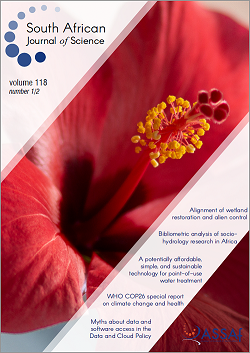Visible light photodegradation of methyl orange and Escherichia coli O157:H7 in wastewater
DOI:
https://doi.org/10.17159/sajs.2022/10938Keywords:
catalysis, environmental remediation, pollution, porous materials, wastewater, zeoliteAbstract
Water pollution due to dyes and pathogens is problematic worldwide, and the disease burden is higher in low-income countries where water treatment facilities are usually inadequate. Thus the development of low-cost techniques for the removal of dyes and pathogens in aquatic systems is critical for safeguarding human and ecological health. In this work, we report the fabrication and use of a photocatalyst derived from waste from coal combustion in removing dyes and pathogens from wastewater. Higher TiO2 loading of the photocatalyst increased the removal efficiency for methyl orange (95.5%), and fluorine-doping improved the disinfection efficacy from 76% to 95% relative to unmodified material. Overall, the work effectively converted hazardous waste into a value-added product that has potential in point-of-use water treatment. Future research should focus on upscaling the technique, investigating the fate of the potential of the photocatalysts for multiple reuse, and the recovery of TiO2 in treated water.
Significance:
- The study provides a pathway for the fabrication of a value-added product from coal fly ash waste.
- The use of the proposed nanocomposite material for wastewater treatment represents a potentially affordable, simple, and sustainable technology for point-of-use water treatment.
Published
Issue
Section
License

All articles are published under a Creative Commons Attribution 4.0 International Licence
Copyright is retained by the authors. Readers are welcome to reproduce, share and adapt the content without permission provided the source is attributed.
Disclaimer: The publisher and editors accept no responsibility for statements made by the authors
How to Cite
- Abstract 961
- PDF 840
- EPUB 512
- XML 646












.png)